Mac's Believe It or Not!
by John McDougald
Reprinted from "Crown Jewels of the Wire", February 2002, page 30
There have been a lot of favorable comments out the insulators in color
featured in "Mac's Believe It or Not!" in the December 2001 and
January 2002 issues. And, it is great to hear back from folks with additional
information. From one of the longest and youngest collectors I know, Joe
Maurath, Jr. who was the contributing editor of "Insulator Bylines"
for Old Bottle Magazine from July 1974 through May 1981 writes:
"Seeing the photograph of the CD 140 purple Jumbo in the January 2002
issue, I wanted to let the readers know that a CD 140 purple Jumbo was retrieved
by a power company lineman (along with an olive-green and aqua one) from the
side of an abandoned building in Lynn, Massachusetts within an urban renewal
area I spotted in 1974.
"You are correct that the Boston subway system(s)
supplied the majority of (if not most) the rest of the CD 140 Jumbo's. They were
taken from active service from 600 volt DC cables in 1975 by
"collectors" who left the "hot" DC cables on their
85-year-old crossarms which subsequently started subway fires within the
Massachusetts Transit Authority vicinities near Park Street stations....) Yes,
there were injuries/suffocation fatalities back then but nobody really knew
why(!) The MBTA wrote it off apparently as unknown, so did the NIA when I made a
stink about it (especially in my OBX column then). Nobody listened,...oh well,
time goes on...everyone forgets and I have tried to as well.
"I took much
interest in seeing the dark red CD 234 Pyrex-63 in the January 2002 issue of
Crown Jewels of the Wire (p.34). A very nearly identical insulator was shown to
me at the Marlborough (Massachusetts) National in July 1995. It was among
several other rather nice insulators brought to my attention throughout the
duration of the show for my opinion and comment; the owner of the Pyrex had remembered me as insulator editor of
Old Bottle Magazine throughout the
1970s. The middle-aged gentleman was a "walk-in" attendee and had the
red Pyrex well wrapped in a cardboard box. Despite the fact that I gave the
piece a good "going over" for authenticity (as he requested), I have
since assumed that the insulator "might" have been a fake...until I
learned of the one mentioned above in CJ. The owner (I did not make note of his
name) appreciated my thorough inspection of the piece and I my final conclusion
was that I was hedging my bets it could still have been altered in some way but
I concluded it surely looked like true red glass to me. The owner said it was
bought at an estate sale some years before in upstate New York, for around $50.
The only other details about the red Pyrex that I can share are that I made note
that there was a molding "wrinkle" along the outside of its skirt and
that the pinhole had a slight "droop" in the mid-portion of its
threads.
"I took a couple photos of this insulator for my files which I am
sharing with you. The only differences that I can see are that his piece was
produced in an "S" mold and that his appears (maybe) perhaps a shade
lighter in color than the one shown in January CJ. I took the photos outside in
the sunny (hot!) parking lot because of the depth of the insulator's color.
"I do not know whatever became of the owner or the piece. I believe his
insulator was shown to a few others at the show and likely was quickly passed
off as a phony. I am glad that I gave the red Pyrex a second look... perhaps
since the "D" mold one has come to light, let's hope the "S"
mold eventually will resurface once again."

Red Pyrex "S" mold.

Crown Jewels of the Wire is proud to feature some colorful CD 133's and CD
134's on the cover and in the color insert this month. The cover was reserved
for one of the most unusual insulators we have seen in the past several years.
It comes from the collection of M. J. and Esther Israel of Keyes, OK. They were
early collectors and were good friends of Gerald and Esta Brown, collecting
pioneers in the insulator hobby. The cover piece was purchased from Esta for $12
when she was in the process of dismantling her magnificent glass insulator
collection.
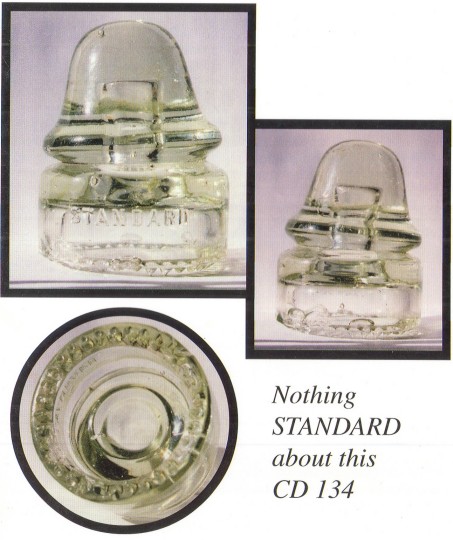
Cover Photo
I think the cover pictures speak for themselves, but in case you
missed it, how often do you get to say "threadless" and "sharp
drip points" when describing the same insulator. Although the only
embossing is "STANDARD" on the front skirt, the piece appears to be a
Hemingray product. It might have been a CD 133 or a CD 134 before it sagged, but
the color is unusual, and the small pinhole defies explanation at this point. M.
J. and Esther were kind enough to lend this piece to us to take to the
Scottsdale National in 1999, but even sharing it with the Hemingray experts
didn't result in any solid explanation for this unusual find. Thanks, M. J. and
Esther for sharing. Don't miss their picture in the color insert. We also
featured another gem from their collection on the same page, a CD 133 HG Co.
Standard with nearly solid milk swirling. Thanks, again.
Featured on pages 34-36 are a range of colors the CD 134 Hemingray made
bearing the December 19, 1871 date. The earliest versions are only embossed with
the 1871 date, and they may or may not have a mold letter on the dome or the rear
skirt. A couple of the toughest colors are pictured (depression green, olive
green and peacock blue) along with some more common colors. The May 2, 1893
patent was added to a number of the molds along with the addition of sharp drip
points. One of the things that has always fascinated me about the "double
dated" CD 134's is that on some of them the "Patent May 2 1893"
is engraved on one line (e.g. the purple and amber examples), and in some cases,
it's embossed on two lines (e.g. the violet cobalt example). Several of the
tougher colors (e.g. gingerale and peacock blue) have been seen in both
embossings, so there doesn't seem to be any relationship between color and embossing.
In case you are bemoaning the fact that these rare items will never
end up in your collection, I want to point out that the purple and the amber
pieces pictured (currently both one-of-a-kind to the best of my knowledge) were purchased in antique stores/flea markets in the
last three years - needless to say, well below market value. Paul Ziemer was the
lucky discoverer of the purple piece (featured on the cover of the March 1999 CJ) in the state of Washington. Having already spent his "secret cash
stash" for his wife's anniversary gift, and the shop's "no credit
cards" policy, Paul somehow talked his lovely wife Cheryl into loaning him
$35 plus tax to make his purchase of a lifetime.
The amber piece was purchase by
David Zumalt of Lexington, Missouri, for eight dollars at a flea market. He was
told by the dealer that it came off a pole near his house. The lineman left it
lying on the ground, so the dealer's kids picked it up. The dealer consulted
with his sister on the price (she supposedly knows about this sort of thing.)
The dealer lived in Kansas City.
Follow-ups in both cases yielded no additional information about the history
of the pieces or any "relatives." Hey, maybe having your last name
begin with "Z" is a good way to uncover rare insulators??? Ziemer and
Zumalt - Believe It Or Not!
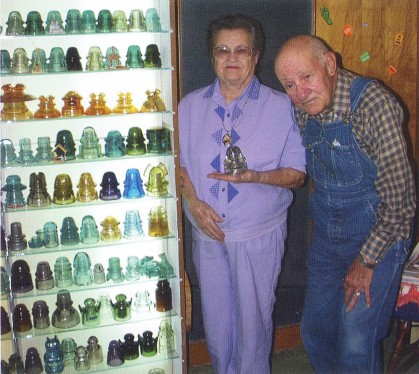
As cute a couple now as they were during the pioneer days of collecting, M.J.
and Esther Israel of Keyes, Oklahoma still treasure the "clear"
insulator they purchased years ago. Just as special is the CD 133 H.G.Co.,
Standard signal that is one of the most densely filled blue aqua pieces filled
with milk swirls.

Smooth base CD 134 had only the one patent date -- PAT. DEC. 19 1871
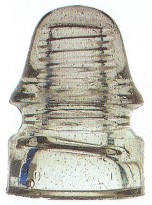 |
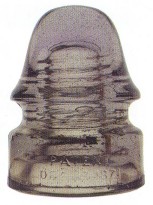 |
|
Almost Clear |
Light Purple/SCA |
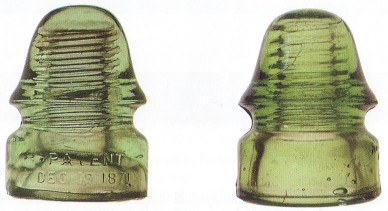 |
|
Light Green |
Depression Green |
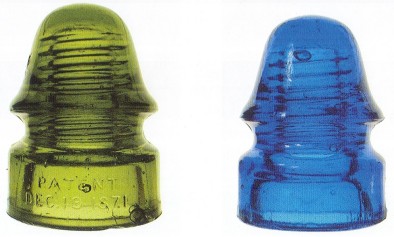 |
|
Olive Green |
Peacock Blue |
|
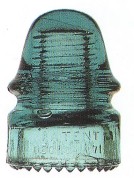
|
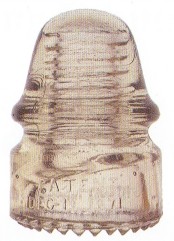
|
|
Aqua
Adding drip points to CD 134 also added a second patent date. |
|
Straw-like Ginger Ale |
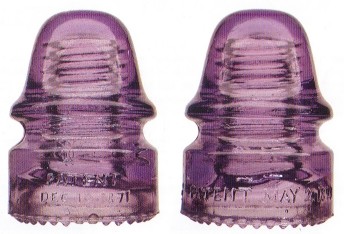 |
|
Purple |
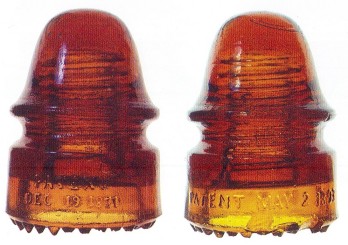 |
|
Orange Amber |
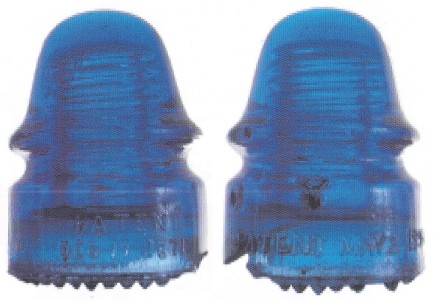
Peacock Blue
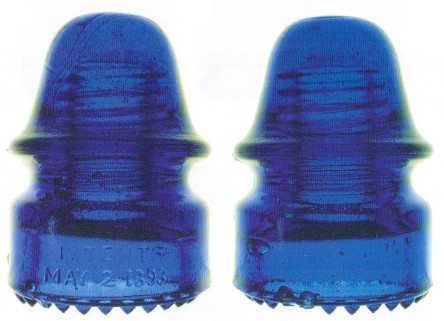
Violet Cobalt Blue
| 